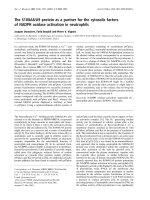Báo cáo y học: "The website contains a wealth of information regarding the management of trauma victims, as well as news about upcoming conferences and event" potx
Bạn đang xem bản rút gọn của tài liệu. Xem và tải ngay bản đầy đủ của tài liệu tại đây (24.19 KB, 2 trang )
197
Available online />The trauma.org website attempts to ‘promote and
disseminate the knowledge and practice of injury prevention
and trauma care throughout the world’. The website contains
a wealth of information regarding the management of trauma
victims, as well as news about upcoming conferences and
events in the field. The present review will focus on the
‘moulage’ link, which can be reached from the main
trauma.org homepage.
The ‘moulage’ section of the site contains numerous clinical
scenarios that focus on various topics in trauma care. These
scenarios are subdivided into the broad categories: initial
assessment of the trauma patient, prehospital care, cervical
spine clearance, pediatric trauma, neurotrauma and trauma
team leader decision scenarios.
Each ‘moulage’ is interactive and begins with a description
of a trauma. The user is then confronted with a
management issue and several possible diagnostic or
therapeutic options. If the correct treatment strategy is
chosen, the scenario progresses and new clinical
dilemmas and management choices involving the same
patient are presented. If the user makes a catastrophic or
an obviously incorrect choice, the ‘moulage’ is terminated
(typically this is indicated by the demise of the hypothetical
patient) and the user must return to the beginning of the
scenario. If the user makes an incorrect but not fatal
choice, the error in judgment is highlighted by the program
but the user is still allowed to work through the remainder
of the case.
I was very impressed by the scenarios that have been
developed in each of the topic areas. The process of working
through a ‘moulage’ is certainly educational, and the
designers of the website have done an outstanding job in
ensuring that the material presented is relevant and current.
The photographs (typically of trauma pathology) and
radiology images are also excellent, and add significantly to
the experience of navigating through a case.
The narratives for each scenario are presented in a
conversational manner, but often slip into melodrama. The
authors obviously have a keen sense of humor, but after
completing several of the ‘moulages’ I became impatient with
the unnecessary prose and editorial comments. Similar
sentiments were echoed by several of the other individuals
that were used as a test audience.
I demonstrated the site to a wide audience including a
layperson, a medical student and several intensive care
residents. All of these test subjects were very impressed by
the site, and found it useful and educational. The medical
student seemed to derive the most pleasure and educational
value from the site. However, the residents also indicated
that the scenarios had contributed to their understanding of
trauma practice. They were disappointed that some of the
explanations provided were not more detailed.
The ‘trauma team leader decision scenarios’ were uniformly
given the highest ratings. All users appreciated the
succinctness of these scenarios and the more focused
nature of the questions. The explanations given for both
correct and incorrect answers in these scenarios were more
comprehensive than in the other sections.
To properly maneuver the site, users must have either
Netscape Navigator 2.0+, Internet Explorer 3.01+ or another
internet browser that supports frames and Javascript.
Web report
trauma.org — moulage
Damon C Scales
Fellow, Critical Care, University of Toronto, Canada
Correspondence: Damon C Scales,
Reported: 2 February 2003 Critical Care 2003, 7:197-198 (DOI 10.1186/cc2159)
Published online: 21 February 2003
This article is online at />© 2003 BioMed Central Ltd (Print ISSN 1364-8535; Online ISSN 1466-609X)
Website trauma.org — moulage
URL (owned and developed by trauma.org)
Cost Individual subscription: Free
Keywords critical care, education, emergencies, intensive care, wounds and injuries
198
Overall, I found the trauma scenarios to be well presented
and educational. More importantly, they were actually fun to
work through, and seemed to be appreciated by a diverse
group of medical users. I would highly recommend a visit to
this site to anyone with an interest in trauma care.
Best feature
Interactive nature of the clinical scenarios.
Worst feature
Several of the vignettes contain unnecessary text that
becomes a nuisance to skim through.
Wish list
More scenarios in the format of the ‘trauma team leader
decision scenarios’.
Other links
MDchoice.com —
This website contains two interactive scenarios for each of the
topic areas of advanced cardiac life support, of acute leg
swelling and of acute coronary syndrome. The cases are
detailed and well presented. Each ‘decision point’ has several
correct answers, and I found that this made the scenarios
slightly less challenging than they might have been if only one
correct response had been presented. Medical students and
residents are likely to gain the most benefit from working
through the cases on this website, which is free.
ACLS.net —
This free website contains two interactive scenarios that
concentrate on basic life support and advanced cardiac life
support algorithms. Many clinicians may find these scenarios
somewhat simplistic, but individuals who have recently
completed the basic life support course or the advanced
cardiac life support course may find them useful for reviewing
important resuscitation principles.
Competing interests
None declared.
Critical Care April 2003 Vol 7 No 2 Scales









